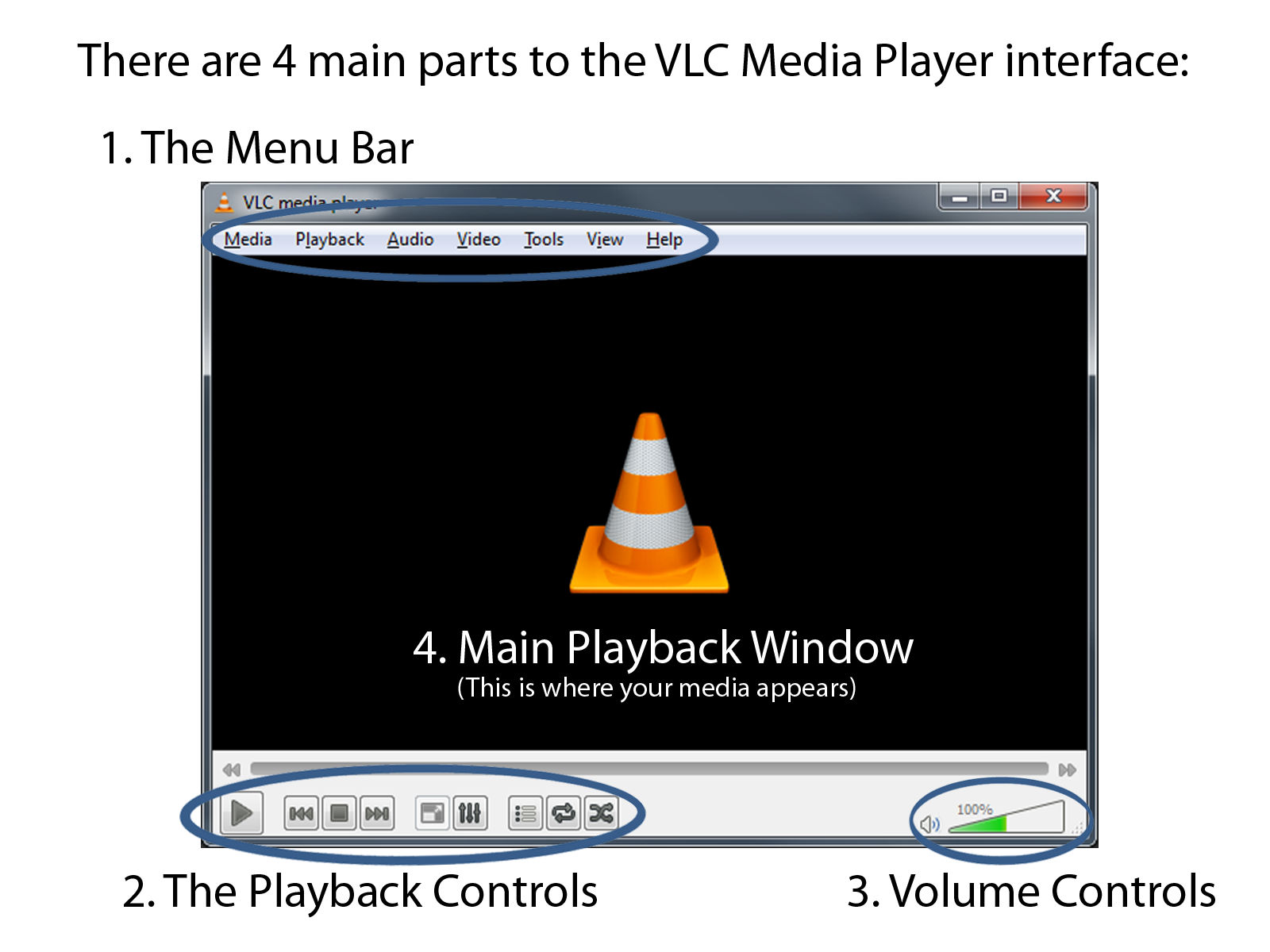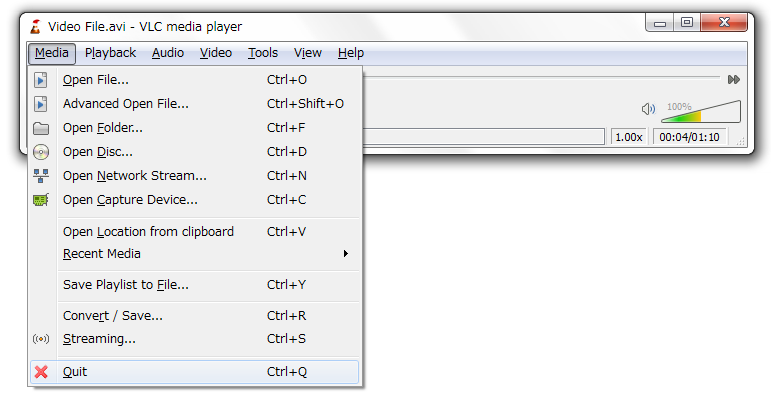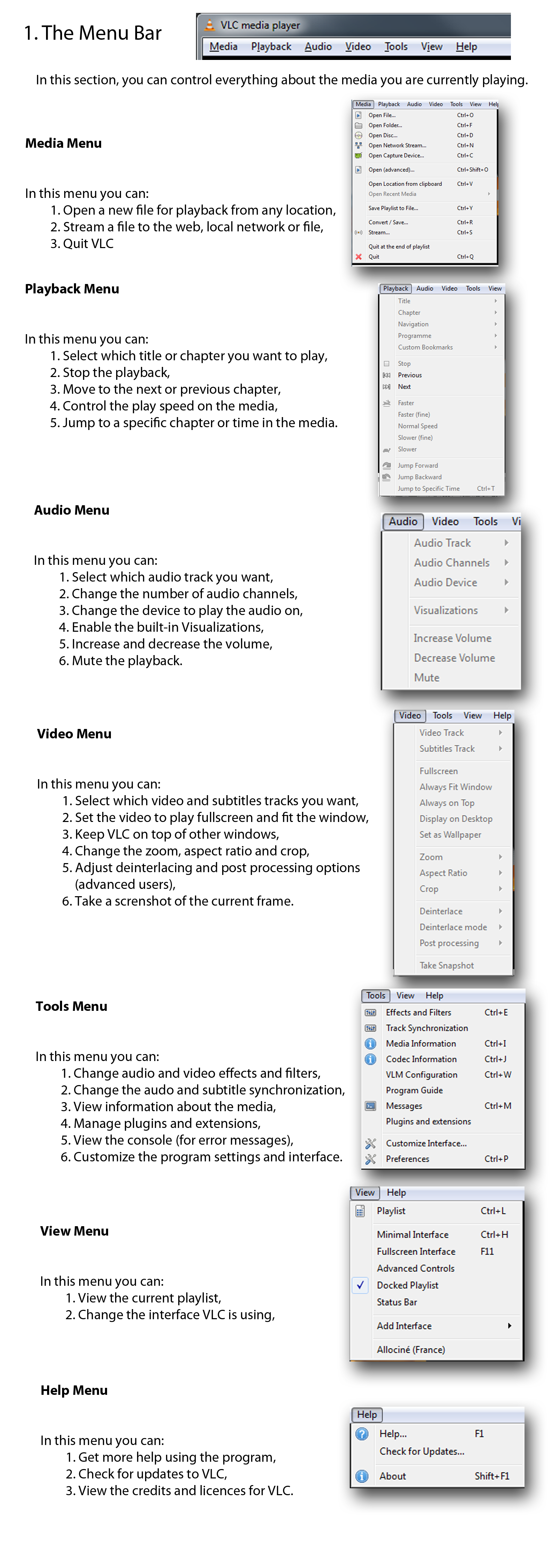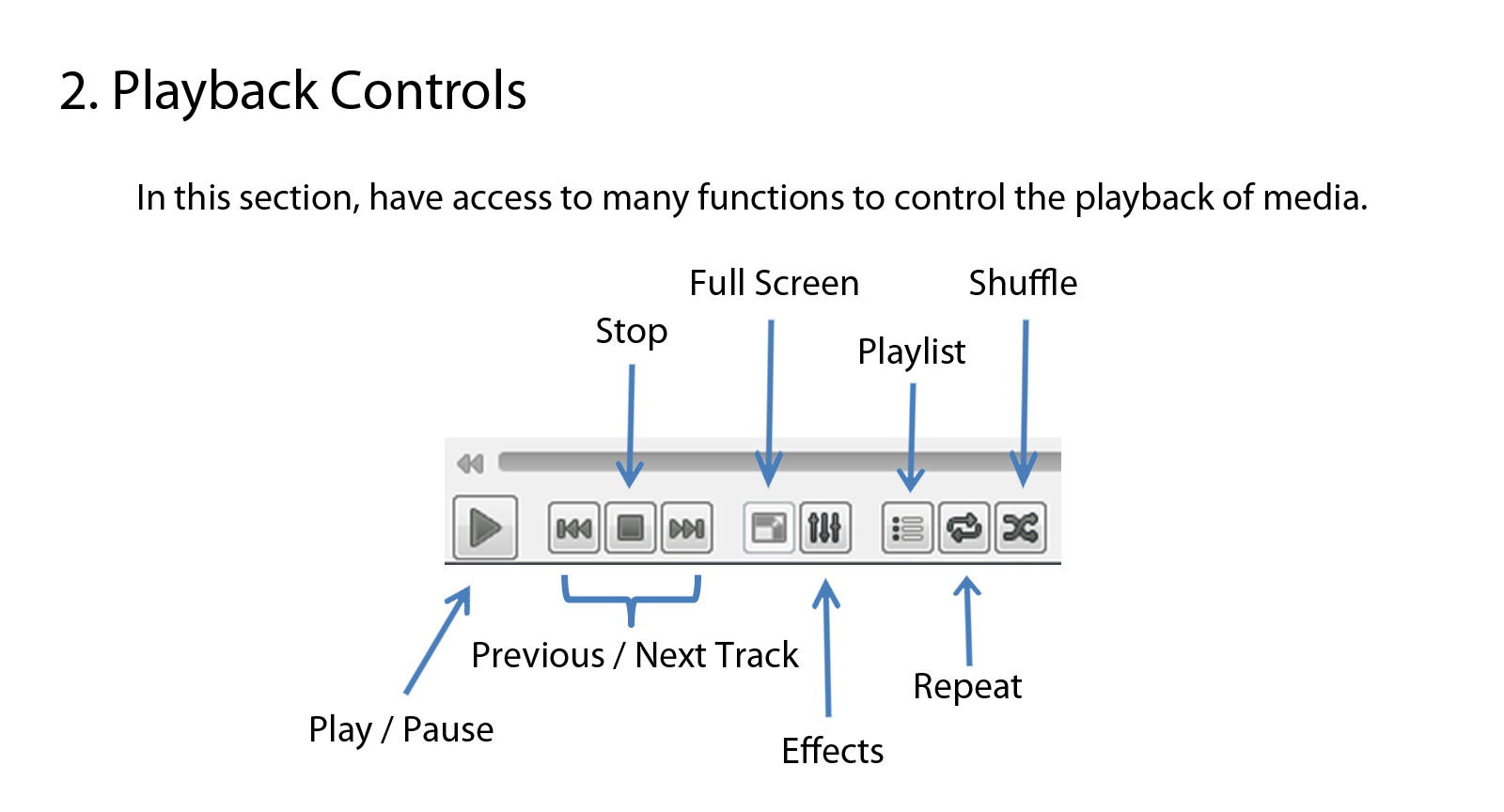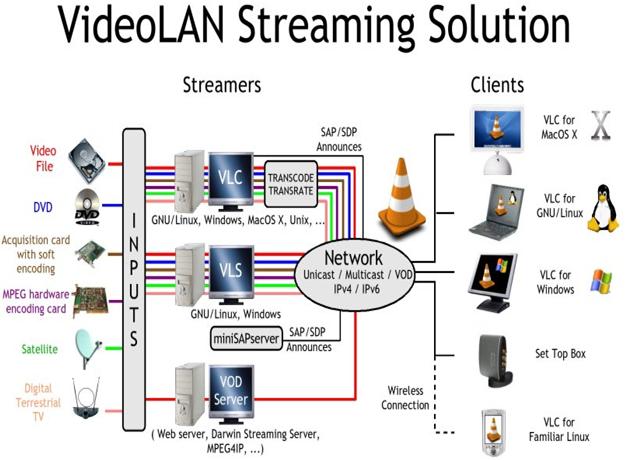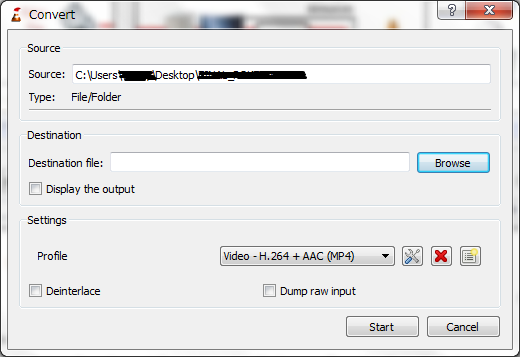|
|
| (59 intermediate revisions by 13 users not shown) |
| Line 1: |
Line 1: |
| − | {{RightMenu|documentation play howto toc}} VLC has several interfaces: | + | {{RightMenu|Documentation TOC}} |
| − | | |
| − | *A cross-platform interface, for Windows and GNU/Linux, called wxWidgets,
| |
| − | *A native Mac OS X interface, and
| |
| − | *A skinnable interface for Windows and GNU/Linux.
| |
| − | | |
| − | Screenshots below are drawn from the various interfaces, but VLC's functions work essentially the same on all operating systems.
| |
| | | | |
| | ==General Interface Description== | | ==General Interface Description== |
| | | | |
| | VLC has several interfaces: | | VLC has several interfaces: |
| − | *A cross-platform interface for Windows and GNU/Linux, which is called wxWidgets | + | *A cross-platform interface for Windows and GNU/Linux, which is called [[Qt]]. |
| − | *A native Mac OS X interface | + | *A native Mac OS X interface. |
| − | *An interface which supports skins for both Windows and GNU/Linux. | + | *An interface that supports skins for both Windows and GNU/Linux. |
| | | | |
| − | Below are screenshots of VLC on various interfaces. Despite these different interfaces, VLC's functions essentially work the same on all operating systems.
| + | The operation of VLC is essentially the same in all the interfaces. |
| | | | |
| − | ===Windows and GNU/Linux (wxWidgets)=== | + | === Windows and GNU/Linux (Qt) === |
| | + | The screenshot below shows the default interface in VLC 2.0. More features can be displayed by selecting them in the ''View'' menu. |
| | | | |
| − | The interface shown below is the default for Windows and GNU/Linux (although this screenshot is from Windows, it will look similar on GNU/Linux). More features can be displayed, by selecting them in the ''View'' menu.
| + | [[File:Page1.png|480x360px]]<br> |
| | | | |
| − | [[Image:Default Interface.PNG|center|]] | + | See also [[Documentation:Play HowTo/Basic Use/VLC 1.2 Interface on Windows 7|VLC Interface 2.0 on Windows 7]] |
| | | | |
| | ===Mac OS X=== | | ===Mac OS X=== |
| | + | This screenshot shows the default interface that VLC had on Mac OS X until version 1.1: |
| | + | [[File:Default Interface Mac.PNG|center|]] |
| | | | |
| − | The interface shown below is the default for Mac OS X.
| + | Since version 2.0 the interface has been redesigned. See [[Documentation:Play_HowTo/Basic_Use/Interface_OSX|OSX 2.0 interface]]. |
| | | | |
| − | [[Image:Default Interface Mac.PNG|center|]]
| + | == Starting VLC Media Player in Windows == |
| | | | |
| − | == Starting VLC Media Player ==
| + | In Windows XP: Click '''Start''' -> '''Programs''' -> '''VideoLAN''' -> '''VLC media player'''. |
| | | | |
| − | To start VLC Media Player:
| + | In Windows 7: Click '''Start''' -> '''All Programs''' -> '''VideoLAN''' -> '''VLC media player'''. |
| | | | |
| − | #Select '''Programs''' from the '''Start''' menu.
| + | VLC is shown on the screen and a small icon {{VLC icon}} is shown in the system tray. |
| − | #Select '''VideoLAN''' and select the '''VLC media player'''.
| |
| | | | |
| − | Or:
| + | == Stopping VLC Media Player == |
| | | | |
| − | #Type in your console '''vlc'''
| + | There are three ways to quit VLC: |
| | + | *Right click the VLC icon ({{VLC icon}}) in the tray and select '''Quit''' (''Alt-F4''). |
| | + | *Click the '''Close''' button in the main interface of the application. |
| | + | *In the '''Media''' menu, select '''Quit''' (''Ctrl-Q''). |
| | | | |
| − | When you start VLC media player, the application appears on the screen and a small icon [[Image:VLC - icon.png]] appears in the taskbar. Click on the icon in the taskbar to show or hide the icon in the taskbar. Hiding the icon does not amount to quitting the application. It does run in the background even when you hide the interface.
| + | [[File:Basic_interface_quit.png]] |
| | | | |
| − | == Stopping VLC Media Player == | + | == Notification Area Icon {{VLC icon}} == |
| | + | Clicking this icon shows or hides the VLC interface. Hiding VLC does not exit the application. VLC keeps running in the background when it is hidden. Right clicking the icon in the notification area shows a menu with basic operations, such as opening, playing, stopping, or changing a media file. |
| | | | |
| − | To quit the application, right click on the [[Image:VLC - icon.png]] icon in the tray and select '''Close''' (''Alt-F4'').<br> ''Or''<br> Click the '''Close''' button in the main interface of the application.
| + | == Main Interface == |
| | + | The main interface has the following areas: |
| | + | * '''Menu bar'''. |
| | + | * '''Track slider''' - The track slider is below the menu bar. It shows the playing progress of the media file. You can drag the track slider left to rewind or right to forward the track being played. When a video file is played, the video is shown between the menu bar and the track slider. <br> '''Note: When a media file is streamed, the track slider does not move because VLC cannot know the total duration. |
| | + | * '''Control Buttons''' - The buttons below the track slider cover all the basic playback features. |
| | | | |
| − | == Taskbar Icon ==
| + | [[File:Page2.png|640px]]<br> |
| | | | |
| − | When VLC media player is running, its icon [[Image:VLC - icon.png]] appears in the taskbar. Click on the icon in the taskbar to show or hide the icon in the taskbar. Hiding the icon does not amount to quitting the application. It does run in the background even when you hide the icon. Basic operations such as opening, playing or stopping a media file, or changing a track can be done from the menu obtained by right clicking the taskbar icon. The main interface contains a couple of sections:
| + | [[Documentation:Play_HowTo/Basic_Use/Menus|Click here to view an explanation of every menu item.]] |
| | | | |
| − | === Main Interface ===
| + | [[File:Playbackcontrols.png|640x480px]] |
| | | | |
| − | '''Menu bar''' <br> The buttons below the track slider contain all the basic playback features. <br> '''Track slider''' <br> The track slider is below the menu bar. It shows the progress of playing the media file. You can drag the track slider left to rewind or right to forward the track being played. When a video file is played, the video appears between the menu bar and track slider. <br> '''Note: When a media file is streamed, the track slider does not move because VLC cannot know the total duration.'''<br>
| + | == Opening media == |
| | | | |
| − | '''Control Buttons''' <br> The buttons below the slider help in controlling the play. <br>
| + | See [[Documentation:Play HowTo/Basic Use 0.9/Opening modes]] |
| | | | |
| − | {| width="60%" border="1"
| + | == Streaming Media Files == |
| − | |-
| |
| − | | width="10%" bgcolor="#F5F5F5" | '''Button'''
| |
| − | | width="50%" bgcolor="#F5F5F5" | '''Description'''
| |
| − | |-
| |
| − | | width="10%" | [[Image:VLC - play button.png|center]]
| |
| − | | width="50%" | Toggles between play and pause (or when no media is playing it simply opens the ''Advance File Option'' dialog box)
| |
| − | |-
| |
| − | | width="10%" | [[Image:VLC - back button.png|center]]
| |
| − | | width="50%" | Moves to the previous track
| |
| − | |-
| |
| − | | width="10%" | [[Image:VLC - stop.png|center]]
| |
| − | | width="50%" | Stops the play
| |
| − | |-
| |
| − | | width="10%" | [[Image:VLC - forward button.png|center]]
| |
| − | | width="50%" | Moves to the next track
| |
| − | |-
| |
| − | | width="10%" | [[Image:VLC - fullscreen.png|center]]
| |
| − | | width="50%" | Toggles the application in a full-screen mode
| |
| − | |-
| |
| − | | width="10%" | [[Image:VLC - playlist.png|center]]
| |
| − | | width="50%" | Displays the playlist and media library
| |
| − | |-
| |
| − | | width="10%" | [[Image:VLC - options.png|center]]
| |
| − | | width="50%" | Displays a menu of options to have audio and video effects, and synchronization of the audio and video media.
| |
| − | |-
| |
| − | | width="10%" | [[Image:VLC - mute.png|center]]
| |
| − | | width="50%" | Toggles between mute and voice. Click on it to mute or un-mute.
| |
| − | |-
| |
| − | | width="10%" | [[Image:VLC - volume.png|center]]
| |
| − | | width="50%" | Volume slider. Displays the volume level. You can adjust the volume by placing the cursor on this icon and moving it left or right. The number indicates the percentage of amplification. Maximum is 200%.
| |
| − | |}
| |
| | | | |
| − | === Additional Information ===
| + | Streaming is a method of delivering audio or video content across a network without the need to download the media file before it is played. You can view or listen to the content as it arrives. It has the advantage that you don't need to wait for large media files to finish downloading before playing them. |
| | | | |
| − | At the bottom of the interface we can find information regarding name of the media file being played, the relative speed at which it is being played, and the elapsed and total duration of the file are displayed. There is an option to increase or decrease the speed of the track.
| + | VideoLan is designed to stream MPEG videos on high bandwidth networks. VLC can be used as a server to stream MPEG-1, MPEG-2 and MPEG-4 files, DVDs and live videos on the network in unicast or multicast. Unicast is a process where media files are sent to a single system through the network. Multicast is a process where media files are sent to multiple systems through the network. |
| | | | |
| − | Right click on the [[Image:VLC - playspeed.png]] icon to change the playing speed of the track.
| + | VLC is also used as a client to receive, decode and display MPEG streams. MPEG-1, MPEG-2 and MPEG-4 streams received from the network or an external device can be sent to one machine or a group of machines. |
| | | | |
| − | {| width="60%" border="1"
| + | [[File:Streamingdiag.JPG]] |
| − | |-
| |
| − | | width="10%" bgcolor="#F5F5F5" | '''Menu'''
| |
| − | | width="10%" bgcolor="#F5F5F5" | '''Option'''
| |
| − | | width="40%" bgcolor="#F5F5F5" | '''Description'''
| |
| − | | width="10%" bgcolor="#F5F5F5" | '''Hotkey'''
| |
| − | |-
| |
| − | | width="10%" align="center" | '''Media'''
| |
| − | | width="10%" align="center" | '''Open File'''
| |
| − | | width="40%" | Select this option to open a media file and play it.
| |
| − | | width="10%" align="center" | ''Ctrl+O''
| |
| − | |-
| |
| − | | width="10%" |
| |
| − | | width="10%" align="center"| '''Advanced Open File'''
| |
| − | | width="40%" | Select this option to open files through a folder, disc, network or a capture device.
| |
| − | | width="10%" align="center" | ''Ctrl+Shift+O''
| |
| − | |-
| |
| − | | width="10%" |
| |
| − | | width="10%" align="center" | '''Open Folder'''
| |
| − | | width="40%" | Select this option to open a folder with multiple media files and play them in order.
| |
| − | | width="10%" align="center" | ''Ctrl+F''
| |
| − | |-
| |
| − | | width="10%" |
| |
| − | | width="10%" align="center" | '''Open Disc'''
| |
| − | | width="40%" | Select this option to open discs with different video format.
| |
| − | | width="10%" align="center" | ''Ctrl+D''
| |
| − | |-
| |
| − | | width="10%" |
| |
| − | | width="10%" align="center" | '''Open Network Stream'''
| |
| − | | width="40%" | Select this option to receive media files from Internet and play them.
| |
| − | | width="10%" align="center" | ''Ctrl+N''
| |
| − | |-
| |
| − | | width="10%" |
| |
| − | | width="10%" align="center" | '''Open Capture Device'''
| |
| − | | width="40%" | Select this option to receive media files from capture devices such as camcorder, webcam and so on.
| |
| − | | width="10%" align="center" | ''Ctrl+C''
| |
| − | |-
| |
| − | | width="10%" |
| |
| − | | width="10%" align="center" | '''Open Location from clipboard'''
| |
| − | | width="40%" | Select this option to enter the URL or path to the media you want to play.
| |
| − | | width="10%" align="center" | ''Ctrl+V''
| |
| − | |-
| |
| − | | width="10%" |
| |
| − | | width="10%" align="center" | '''Recent Media'''
| |
| − | | width="40%" | Scroll over this option to view recently played media.
| |
| − | | width="10%" align="center" | ''-''
| |
| − | |-
| |
| − | | width="10%" |
| |
| − | | width="10%" align="center" | '''Save Playlist to File'''
| |
| − | | width="40%" | Select this option to save the playlist to a file.
| |
| − | | width="10%" align="center" | ''Ctrl+Y''
| |
| − | |-
| |
| − | | width="10%" |
| |
| − | | width="10%" align="center" | '''Convert/Save'''
| |
| − | | width="40%" | Select this option to convert media files to different media file formats.
| |
| − | | width="10%" align="center" | ''Ctrl+R''
| |
| − | |-
| |
| − | | width="10%" |
| |
| − | | width="10%" align="center" | '''Streaming'''
| |
| − | | width="40%" | Select this option to send media files through network and play them live.
| |
| − | | width="10%" align="center" | ''Ctrl+S''
| |
| − | |-
| |
| − | | width="10%" |
| |
| − | | width="10%" align="center" | '''Quit'''
| |
| − | | width="40%" | Select this option to quit the application.
| |
| − | | width="10%" align="center" | ''Ctrl+Q''
| |
| − | |-
| |
| − | | width="10%" align="center" | '''Audio'''
| |
| − | | width="10%" align="center" | '''Audio Track'''
| |
| − | | width="40%" | Select this option to disable or enable an audio track.
| |
| − | |-
| |
| − | | width="10%" |
| |
| − | | width="10%" align="center" | '''Audio Device'''
| |
| − | | width="40%" | Select this option to convert the stereo audio files to mono and vice-versa.
| |
| − | |-
| |
| − | | width="10%" |
| |
| − | | width="10%" align="center" | '''Audio Channel'''
| |
| − | | width="40%" | Select this option to select a audio channel.
| |
| − | |-
| |
| − | | width="10%" | ''' '''
| |
| − | | width="10%" align="center" | '''Visualization'''
| |
| − | | width="40%" | Select this option to display splashes of colour and geometric shapes while listening to an audio file.
| |
| − | |-
| |
| − | | width="10%" align="center" | '''Video'''
| |
| − | | width="10%" align="center" | '''Video Track'''
| |
| − | | width="40%" | Select this option to disable or enable a video track.
| |
| − | |-
| |
| − | | width="10%" | ''' '''
| |
| − | | width="10%" align="center" | '''Subtitles'''
| |
| − | | width="40%" | Select this option to load subtitle files for video files requiring subtitles.
| |
| − | |-
| |
| − | | width="10%" | ''' '''
| |
| − | | width="10%" align="center" | '''Full Screen'''
| |
| − | | width="40%" | Select this option to view the media file in the entire screen.
| |
| − | |-
| |
| − | | width="10%" | ''' '''
| |
| − | | width="10%" align="center" | '''Zoom'''
| |
| − | | width="40%" | Select this option to zoom in or zoom out a video track.
| |
| − | |-
| |
| − | | width="10%" | ''' '''
| |
| − | | width="10%" align="center" | '''Deinterlace'''
| |
| − | | width="40%" | Select this option to convert interlaced video signals into non-interlaced form.
| |
| − | |-
| |
| − | | width="10%" | ''' '''
| |
| − | | width="10%" align="center" | '''Aspect Ratio'''
| |
| − | | width="40%" | Select this option to adjust the width to height ratio of the video.
| |
| − | |-
| |
| − | | width="10%" | ''' '''
| |
| − | | width="10%" align="center" | '''Crop'''
| |
| − | | width="40%" | Select this option to crop the edges of a video track.
| |
| − | |-
| |
| − | | width="10%" | ''' '''
| |
| − | | width="10%" align="center" | '''Always on Top'''
| |
| − | | width="40%" | Select this option to display the application always on top when other applications or files are open.
| |
| − | |-
| |
| − | | width="10%" | ''' '''
| |
| − | | width="10%" align="center" | '''Direct X wall paper'''
| |
| − | | width="40%" | Select this option to make the video which is being displayed to become the wall paper.
| |
| − | |-
| |
| − | | width="10%" | ''' '''
| |
| − | | width="10%" align="center" | '''Snapshot'''
| |
| − | | width="40%" | Select this option to capture snapshots of video being displayed.
| |
| − | |-
| |
| − | | width="10%" align="center" | '''Playback'''
| |
| − | | width="10%" align="center" | '''Go to specific time'''
| |
| − | | width="40%" | Select this option to move the track slider to a specific frame of the video or audio file. The media file starts playing from that instance.
| |
| − | |-
| |
| − | | width="10%" | ''' '''
| |
| − | | width="10%" align="center" | '''Bookmarks'''
| |
| − | | width="40%" | Select this option to bookmark the media file.
| |
| − | |-
| |
| − | | width="10%" | ''' '''
| |
| − | | width="10%" align="center" | '''Title'''
| |
| − | | width="40%" | Select this option to randomly access a particular movie in a DVD.
| |
| − | |-
| |
| − | | width="10%" | ''' '''
| |
| − | | width="10%" align="center" | '''Chapter'''
| |
| − | | width="40%" | Select this option to randomly access a particular chapter in a movie.
| |
| − | |-
| |
| − | | width="10%" | ''' '''
| |
| − | | width="10%" align="center" | '''Program'''
| |
| − | | width="40%" | To be added
| |
| − | |-
| |
| − | | width="10%" | ''' '''
| |
| − | | width="10%" align="center" | '''Navigation'''
| |
| − | | width="40%" | Select this option to navigate to different titles and their corresponding chapters.
| |
| − | |-
| |
| − | | width="10%" align="center" | '''Playlist'''
| |
| − | | width="10%" align="center" | '''Additional Sources'''
| |
| − | | width="40%" | Select this option to access the additional sources such as podcasts, SAP announcements, radio and TV shoutcasts, French TV and Freebox TV.
| |
| − | |-
| |
| − | | width="10%" | ''' '''
| |
| − | | width="10%" align="center" | '''Show Playlist'''
| |
| − | | width="40%" | Select this option to view and play the media files listed in the playlist.
| |
| − | |-
| |
| − | | width="10%" | ''' '''
| |
| − | | width="10%" align="center" | '''Load Playlist File'''
| |
| − | | width="40%" | Select this option to load the playlist files.
| |
| − | |-
| |
| − | | width="10%" | ''' '''
| |
| − | | width="10%" align="center" | '''Save Playlist to File'''
| |
| − | | width="40%" | Select this option to save the current playing media in the preferred format.
| |
| − | |-
| |
| − | | width="10%" | ''' '''
| |
| − | | width="10%" align="center" | '''Save Playlist to File'''
| |
| − | | width="40%" | Select this option to save the current playing media in the preferred format.
| |
| − | |-
| |
| − | | width="10%" align="center" | '''Tools'''
| |
| − | | width="10%" align="center" | '''Playlist'''
| |
| − | | width="40%" | Select this option to view and play the media files listed in the playlist.
| |
| − | |-
| |
| − | | width="10%" | ''' '''
| |
| − | | width="10%" align="center" | '''Extended Settings'''
| |
| − | | width="40%" | Select this option to adjust the audio and video effects.
| |
| − | |-
| |
| − | | width="10%" | ''' '''
| |
| − | | width="10%" align="center" | '''Add Interface'''
| |
| − | | width="40%" | Select this option to view VLC media player using different interfaces.
| |
| − | |-
| |
| − | | width="10%" | ''' '''
| |
| − | | width="10%" align="center" | '''Minimal view'''
| |
| − | | width="40%" | Select this option to have a minimal view of the application.
| |
| − | |-
| |
| − | | width="10%" | ''' '''
| |
| − | | width="10%" align="center" | '''Fullscreen Interface'''
| |
| − | | width="40%" | Select this option to have a full screen view of the application.
| |
| − | |-
| |
| − | | width="10%" | ''' '''
| |
| − | | width="10%" align="center" | '''Advanced controls'''
| |
| − | | width="40%" | Select this option to access snapshot and loop controls.
| |
| − | |-
| |
| − | | width="10%" | ''' '''
| |
| − | | width="10%" align="center" | '''Messages'''
| |
| − | | width="40%" | To be added
| |
| − | |-
| |
| − | | width="10%" | ''' '''
| |
| − | | width="10%" align="center" | '''Media Information'''
| |
| − | | width="40%" | Select this option to view information regarding the media file being played.
| |
| − | |-
| |
| − | | width="10%" | ''' '''
| |
| − | | width="10%" align="center" | '''Codec Information'''
| |
| − | | width="40%" | Select this option to view codec information of the media file being played.
| |
| − | |-
| |
| − | | width="10%" | ''' '''
| |
| − | | width="10%" align="center" | '''Bookmarks'''
| |
| − | | width="40%" | Select this option to bookmark the media file.
| |
| − | |-
| |
| − | | width="10%" | ''' '''
| |
| − | | width="10%" align="center" | '''VLM Configuration'''
| |
| − | | width="40%" | To be added
| |
| − | |-
| |
| − | | width="10%" | ''' '''
| |
| − | | width="10%" align="center" | '''Preferences'''
| |
| − | | width="40%" | Select this option to give preferred settings to audio, video, subtitles, codecs and hotkeys.
| |
| − | |}
| |
| | | | |
| − | == Opening modes ==
| + | '''To stream a file''': |
| | | | |
| − | See [[Documentation:Play HowTo/Basic Use 0.9/Opening modes]]
| + | #From the '''Media''' menu, select '''Open Network Stream'''. The ''Open Media'' dialog box loads with the ''Network'' tab selected. |
| | + | #In the '''Please enter a network URL''' text box, Type the network URL. |
| | + | #Click '''Play'''. |
| | | | |
| − | == Streaming Media Files ==
| + | Note: When VLC plays a stream, the track slider shows the progress of the playback. |
| | | | |
| − | Streaming is a method of delivering audio or video content across the network without downloading a file before it is played. You can view or listen to the content as it arrives. The advantage is that you need not download large files to watch a movie or listen to music. VideoLAN is designed to stream MPEG videos on high bandwidth networks. | + | For more information, refer to [[Documentation:Streaming HowTo/Receive and Save a Stream]] |
| | | | |
| − | VLC can be used as a server to stream MPEG-1, MPEG-2 and MPEG-4 files, DVDs and live videos on the network in unicast or multicast.
| + | [[File:Vlc_network_stream.PNG|480x360px]] |
| | | | |
| − | Unicast refers to a process where media files are sent to a single system through the network. Multicast refers to a process where media files are sent to multiple systems through the network.
| + | == Converting and Saving a Media File Format == |
| | | | |
| − | VLC is also used as a client to receive, decode and display MPEG streams. MPEG-1, MPEG-2 and MPEG-4 streams received from the network or video from a camcorder can be sent to one machine or a group of machines. | + | VLC can convert media files from one format to another. |
| | | | |
| − | [[Image:Streamingdiag.JPG]]
| + | '''To convert a media file''': |
| | | | |
| − | To stream a file:
| + | #From the '''Media''' menu, select '''Convert/Save'''. The ''Open media'' dialog window appears. |
| | + | #Click '''Add...'''. A file selection dialog window appears. |
| | + | #Select the file you want to convert and click '''Open'''. The ''Convert'' dialog window appears. |
| | + | #In the '''Destination file''' text box, indicate the path and file name where you want to store the converted file. |
| | + | #From the '''Profile''' drop-down, select a conversion profile. |
| | + | #Click '''Start'''. |
| | | | |
| − | #Select '''Streaming''' from the '''Media''' menu. The Open dialog box is displayed. The '''Open File''' tab is selected by default.
| + | [[File:Basic_interface_convert.png]] |
| − | #Select the media file from the options available such as a file, a network, a disc or a capture device.
| |
| − | #Click on '''Stream'''. The Stream Output dialog box is displayed. Refer to [[Documentation:Play_HowTo/Advanced_Use_of_VLC#Specifying_Streaming_Options|Specifying Streaming Options]]
| |
| − | #Click on '''Stream''' in the Stream Output dialog box.
| |
| − | | |
| − | Note: When the streaming is being done, the slider moves to show the progress.
| |
| − | | |
| − | == Converting and Saving a Media File Format ==
| |
| | | | |
| − | VLC media player is the best option for multimedia conversion. It can convert different media formats to the format of your preference. To convert a media file
| + | {{Documentation}} |
| | | | |
| − | #Select '''Open File''' from the '''Media''' menu. The Open dialog box is displayed.
| + | [[Category:Interfaces|*]] |
| − | #Select a media file and click on the '''Open''' button. The media file is played.
| |
| − | #Select '''Convert/Save''' from the '''Media''' menu. The Open dialog box is displayed.
| |
| − | #Select the media file and click on '''Convert'''. The Stream Output dialog box is displayed. Refer to [[Documentation:Play_HowTo/Advanced_Use_of_VLC#Specifying_Streaming_Options|Specifying Streaming Options]]
| |
![]() is shown in the system tray.
is shown in the system tray.
 ) in the tray and select Quit (Alt-F4).
) in the tray and select Quit (Alt-F4).
